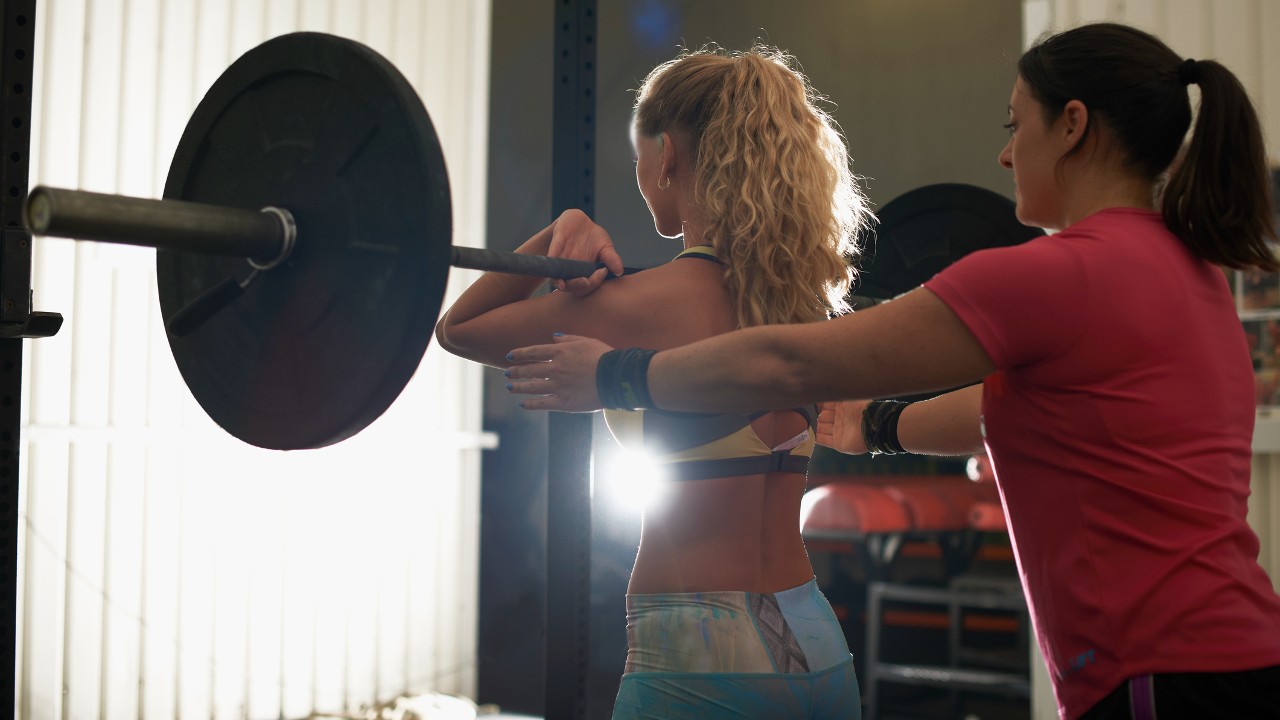
The Benefits Of Weightlifting
Resistance training isn’t just about getting bigger biceps, although that is a welcome bonus. It benefits your health in all sorts of ways. “It stimulates muscles to grow, bones to strengthen and fat to break down,” says personal trainer Dan Wheeler, whose iron dedication landed him the cover of Men’s Fitness Australia in 2013.
That’s why the NHS (hasn’t been on the cover of Men’s Fitness, but still worth listening to) recommends that every adult fits in a minimum of two strength sessions a week, hitting all the major muscle groups. This is especially important as you get older, when a strong frame can help you to avoid problems with your joints and bones.
Furthermore, the mental benefits of any kind of exercise shouldn’t be underestimated, and you could well find that spending some quality time in the weights room each week helps you to clear your head.
“For me it’s a form of meditation,” says Wheeler. “It can be really empowering – both physically and mentally – providing a daily dose of achievement every time you complete a rep, set or workout.”
There are myriad benefits to weightlifting, then, and it’s worth thinking about which one in particular you’re hoping to achieve with your own training. Identifying your primary goal for picking up a pair of dumbbells will give you the motivation to keep doing it consistently.
You’re Ready To Lift When…
Not everyone is ready to dive headfirst into the weights rack. Coach Tom Hamilton highlights these strength markers as a guide for whether you’re ready to load up:
- 30 press-ups in one go
- Five pull-ups
- A perfect bodyweight squat (heels down, knees wide, back flat)
- Jump explosively
“Ticking all these off would put you above the average population,” says Hamilton. “That’s a good sign your muscles have plenty of fast-twitch fibres and the capacity to get strong.”
Sign up for workout ideas, training advice, reviews of the latest gear and more.
Kit Essentials
Weights room floors have hosted everything from muddy Golas to the contents of Derek Zoolander’s wardrobe. It seems that anything goes when it comes to apparel. But if you’re squatting heavy, a crucial swap is to replace your squishy-soled trainers with hard-soled shoes designed for lifting (Chuck Taylors will work too) that don’t compress. Our guide to the best weightlifting shoes will help you find pairs worth buying.
Hamilton swears by the simple training logbook. “Writing down your workout and tracking your lifts and numbers is crucial, whether you’re a beginner or an advanced lifter,” he says. It’ll ensure you don’t waste time devising a workout on the fly, it keeps you accountable so you don’t slack off and you’ll see in black and white if you’re not progressing.
Where To Start
Despite its abundant benefits, the weights room can be an intimidating place. With so many bewildering contraptions, the constant clink of iron on iron and all that testosterone sloshing around the room, it’s tempting to camp out in a corner with a couple of dumbbells.
However, while you can get a good-quality workout done with just a pair of dumbbells and a small patch of floor space, this really isn’t the best use of your gym membership. If you’re a beginner worried about stepping up to the free weights plate, start with the resistance machines.
“They can help you get familiar with which muscles you’re working, and allow you to learn technique without the risk of a loaded barbell guillotining you on the bench,” says Hamilton. We even have a gym machine workout plan for beginners to follow.
Once you’ve got stronger and more confident with the movement patterns involved in common lifts, it’s worth leaving those machines behind at least some of the time, because using free weights recruits more muscles and helps build functional strength that will translate to the outside world. You can start with dumbbells and kettlebells if the barbell still seems a bridge too far, moving on to the bar when you really want to pile on the weight and make big gains.
Are Personal Trainers Worth It?
If you’re going to spend the money just once, do it at the start. Laying down a firm foundation by learning proper technique will help you progress quickly – and painlessly. “I jumped in at the deep end with a killer arms workouts,” says Wheeler. “I could barely hold a pen for a week afterwards. When I recovered, I set my ego aside and focused on learning the right form for the key lifts, especially the deadlift and back squat.”
“Choosing the right PT can be a roll of the dice,” says Hamilton, who compares it to putting your faith in a new mechanic. Before handing your metaphorical car keys over, get a recommendation from a friend.”
How Much Training Will Get Results
“If you go from zero effort to three 30-minute sessions a week you’re going to see results,” says Wheeler. To get the greatest benefit, pick compound, multi-joint exercises that work your whole body. This means the back squat, deadlift, bench press and overhead press, and variations of these moves.
How To Warm Up
Don’t chug along on the treadmill for 10 minutes then hop on the bench press. “Preparing your body for the specific exercise you’re about to work is far better than getting slightly out of breath,” says Wheeler. So with the bench press, say, you want to prepare your wrist, elbow, chest and shoulder joints, tendons, ligaments and muscles for pressing before you start loading up the 25kg plates. Do a handful of press-ups and empty-bar presses first. “Increasing blood flow in the area and neurologically stimulating the connection between your mind and muscles will help you lift cleaner, more powerfully and with a reduced risk of injury.”
“Stretching under load will also improve your mobility and range of motion,” says Hamilton. This is especially true if your workout is sandwiched between extensive spells sitting at your desk. Mobilise your hips with pause squats, where you stop for a few seconds when you’re a quarter, half and three-quarters of the way through a rep. Loosen your shoulders by hanging from a pull-up bar for three lots of 30 seconds, and open up your chest with dumbbell flyes.
Easy-To-Follow Weight Training Plans
Rather than cycling through random exercises, follow a proven plan to make the most of every minute in the gym. Here are three programmes that have helped writers we know make progress.
1. Starting strength
This beginner-friendly plan is a simple but effective introduction to barbell training. Three times a week you get to grips with the squat, bench, overhead press and deadlift. While it can be repetitive, you should find regular progression and weekly PB-setting make it seriously rewarding.
Typical workout
- Squat: Sets 3 Reps 5
- Bench press: Sets 3 Reps 5
- Deadlift: Sets 1 Reps 5
2. The Texas Method
Once you’re confident with the core compound lifts, this three-day-a-week plan combining volume, active recovery and intensity will rapidly propel all-over strength. But beware – it can be brutal if you don’t recover properly with good food and ample hangover-free rest.
Typical workout
- Squat: Sets 1 Reps 5 – work up to a new 5RM (five-rep max)
- Bench/overhead press: Sets 1 Reps 5 – work up to a new 5RM
- Power clean: Sets 5 Reps 3
3. Jim Wendler’s 5/3/1
Simple, efficient, hard. You do four “big” moves a week, hitting pre-determined numbers for a couple of sets before a balls-to-the-wall max-rep effort. The (massive) upside: you make noticeable progress with only two days a week in the gym, leaving you plenty of time for hill runs or lying on the sofa.
Typical workout
- Bench press: Sets 3 Reps 5/3/1
- Squat: Sets 3 Reps 5/3/1
How To Avoid It Hurting (Too Much)
If you’ve done any form of resistance training before, chances are you’ve encountered delayed onset muscle soreness. DOMS is the phenomenon of pain felt 12-48 hours following exercise, typically after workouts with moves you’re not used to. It doesn’t mean you’ve done irreversible damage – it’s far more likely to be what strength experts Brad Schoenfeld and Bret Contreras, in a study published in the Strength And Conditioning Journal, called “microscopic tears in connective tissue”. This is one of the key mechanisms – along with mechanical tension and metabolic stress – involved in hypertrophy, ie the increase in size of a muscle.
You don’t have to hurt to grow, although people can develop a (harmless) pleasure/pain addiction where they don’t feel they’ve worked hard enough if they’re not sore. “The most savage DOMS tends to be from high reps of moves with a big eccentric, or lowering, phase that target the hamstrings and glutes, such as Romanian deadlifts and lunges,” says Hamilton.
You can blunt the trauma by increasing your workload gradually with incremental tweaks in weight, reps or sets. Then help the muscles repair faster with active recovery after a workout to increase blood flow and the delivery of oxygen and nutrients to the muscle. For example, after a lunchtime legs workout, avoid stiffening up with Hamilton’s discreet solution: “Sneak off to the disabled toilet every hour to do 20 bodyweight squats.” You’ve always got the emergency cord if you start to seize up.
Mistakes To Avoid
“A lack of consistency,” says Wheeler. “A bad plan done consistently will get you better results than a good plan done haphazardly.” Repetition and routine will give you the structure to learn how your body best responds to exercise and help you achieve results.
Consistency outside the gym is just as important. “If you’re training for an hour a day you’ve still got 23 hours to focus on your diet, hydration and sleep,” Wheeler says.
Finally, you’ll often see inexperienced lifters swing their weights around and bounce the weight plates off the weight stack on machines. Why? Perhaps it makes them feel better because it allows them to lift heavy and kid themselves that they’re lifting well. Experienced lifters keep tension on the target muscle throughout the entire rep, focusing on the contraction and extension.

Sam Rider is an experienced freelance journalist, specialising in health, fitness and wellness. For over a decade he's reported on Olympic Games, CrossFit Games and World Cups, and quizzed luminaries of elite sport, nutrition and strength and conditioning. Sam is also a REPS level 3 qualified personal trainer, online coach and founder of Your Daily Fix. Sam is also Coach’s designated reviewer of massage guns and fitness mirrors.
